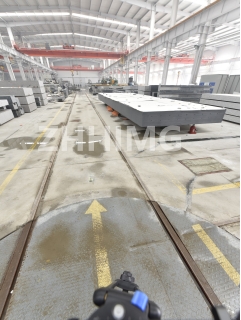Granite component: steady traditional strong
Advantage of Granite components with high precision
1. Excellent stability: Granite after billions of years of geological changes, the internal stress is fully released, the structure is extremely stable. In precision measurement, a stable base is the cornerstone to ensure measurement accuracy. For example, in the coordinate measuring instrument, the granite component as the basic platform can effectively resist the external small vibration interference, so that the measurement probe in the measurement process to maintain accurate position, to ensure the accuracy and repeatability of the measurement data. Even when the ambient temperature and humidity fluctuate, the size change of granite is minimal, providing a reliable benchmark for precision measurement.
2. High hardness and wear resistance: Granite Mohs hardness is usually 6-7, hard texture. In the process of frequently placing and moving the measuring workpiece and the contact friction between the measuring tool and it, the surface of the granite component is not easy to produce wear and scratches. This feature ensures that after long-term use, it can still maintain high-precision flatness and straightness, without frequent replacement of parts, reducing equipment maintenance costs, extending the overall service life of the equipment, especially suitable for measurement scenarios that require high accuracy and long-term stability.
3.Good corrosion resistance: Granite is mainly composed of quartz, feldspar and other minerals, chemical properties are stable, with natural acid resistance, alkali resistance. In some industrial measuring environments where chemical reagents are volatile, granite components will not corroded like metal components, avoiding structural damage and reduced accuracy caused by corrosion, and ensuring the normal operation of measuring equipment in complex chemical environments.
Shortcoming OF Granite components with high precision
1.High processing difficulty: due to the high hardness of granite, the processing equipment and technology requirements are strict. When processing granite into precision components, it is necessary to use professional high-precision cutting and grinding equipment, and the processing process is time-consuming and high cost. For example, to process granite to the micron level of flatness and straightness, it is necessary to go through multiple fine grinding processes, and the scrap rate is relatively high, which limits its production efficiency and large-scale applications to a certain extent.
2. Relatively heavy: The density of granite is large, making the weight of the components made heavier. In some scenarios where the overall weight of the equipment is strictly limited and the location of the measuring equipment needs to be moved or adjusted frequently, the weight of granite components may become an inconvenience factor, increasing the difficulty of equipment installation, debugging and transportation.
Ceramic guide rail: the emerging precision star
Advantage of Precision Ceramic
1. Ultra-high precision: Ceramic materials can achieve extremely high dimensional accuracy and surface finish through advanced processes. In the manufacturing process, the precision control of nanometer level can be achieved, and the deviation of straightness and parallelism is very small. This makes it possible to achieve extremely accurate positioning and movement when moving parts run along ceramic guides in precision measurement equipment, greatly improving the measurement accuracy, and meeting the needs of industries such as semiconductor manufacturing and optical precision measurement, which are nearly demanding in terms of accuracy.
2. Excellent thermal performance: ceramics have the characteristics of low expansion coefficient and are not sensitive to temperature changes. During the operation of the precision measuring equipment, even if the temperature changes due to ambient temperature fluctuations or the equipment's own heating, the dimensional change of the ceramic guide rail is extremely small, which can effectively maintain the stability of the measuring system. Compared with metal guide rails, ceramic guide rails can ensure high-precision operation without complex temperature control measures, reducing the operating cost and maintenance difficulty of equipment.
3. Lightweight design advantage: Compared with granite, ceramic material density is lower, made of rail weight is lighter. In some measurement scenarios that require high dynamic response performance of equipment, such as high-speed scanning and measuring equipment, lightweight ceramic guides can accelerate and decelerate moving parts more rapidly, improve the measurement efficiency and flexibility of the equipment, and reduce the overall load of the equipment, which is conducive to extending the service life of other components.
Shortcoming of Precision Ceramic
1. Brittleness: Although the ceramic material has high hardness, the brittleness is also relatively large. When subjected to a large external impact or collision, the ceramic guide rail is prone to crack or even fracture, which puts forward high requirements for the installation, use and maintenance of the equipment. In actual operation, strict protective measures need to be taken to avoid accidental impact on the guide rail, which limits its application in some environments where there may be a greater risk of mechanical impact.
2. High cost: The manufacturing process of ceramic guide rail is complex, from raw material selection to processing and molding, it requires advanced technology and equipment support. At the same time, due to its production difficulty, the rejection rate is relatively high, resulting in high manufacturing costs of ceramic guide rails. This makes the precision measuring equipment with ceramic guide rail expensive as a whole, and limits its application in enterprises or projects with limited budgets to a certain extent.
In summary, granite components occupy an important position in the traditional precision measurement field by means of stability, wear resistance and corrosion resistance; Ceramic guides are emerging in high-end, emerging precision measurement needs with ultra-high precision, good thermal performance and light weight. In the actual selection, it is necessary to comprehensively consider the equipment use environment, accuracy requirements, budget and other factors, weigh the advantages and disadvantages of the two, and make the most appropriate decision.
Post time: Mar-28-2025

